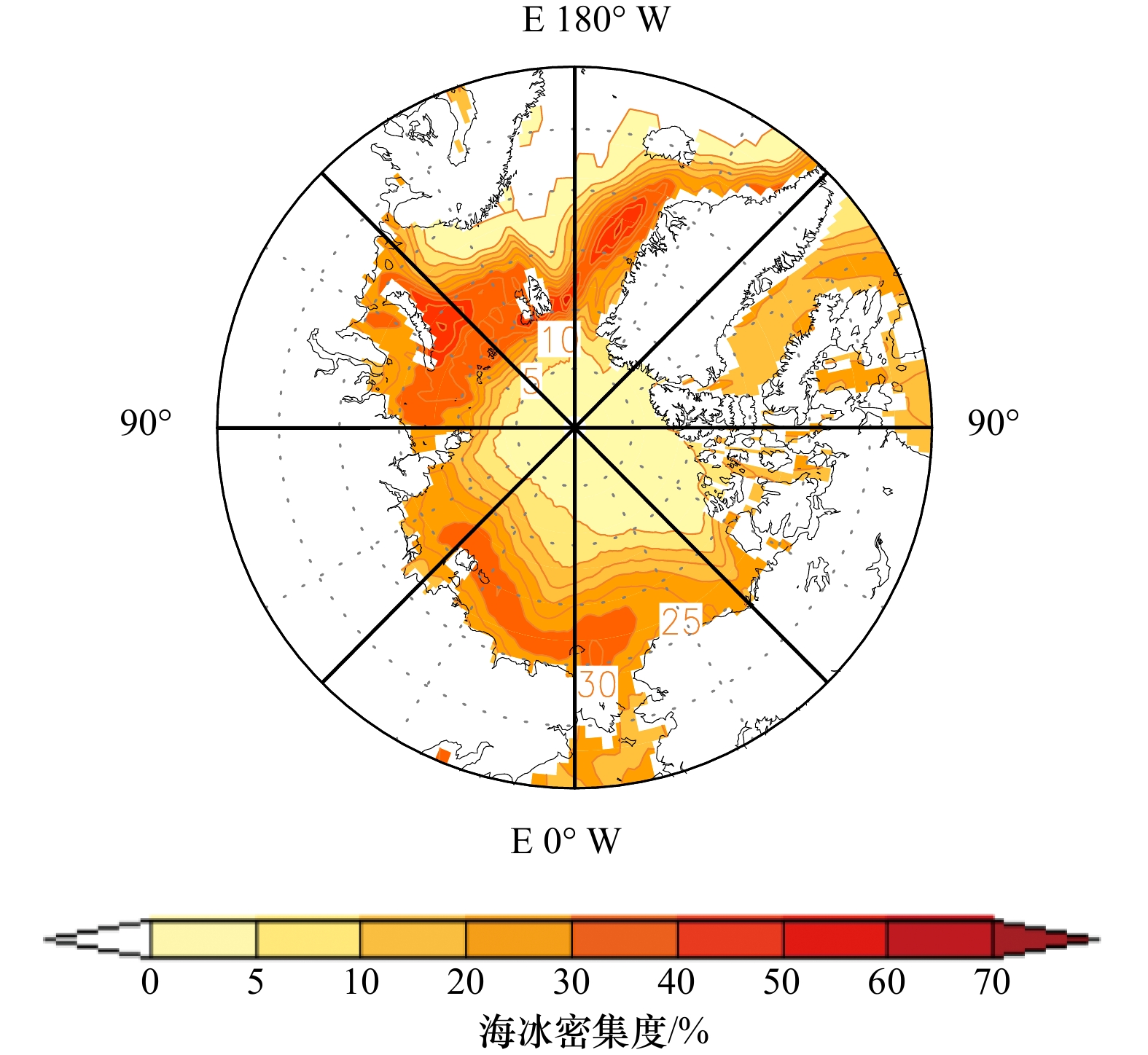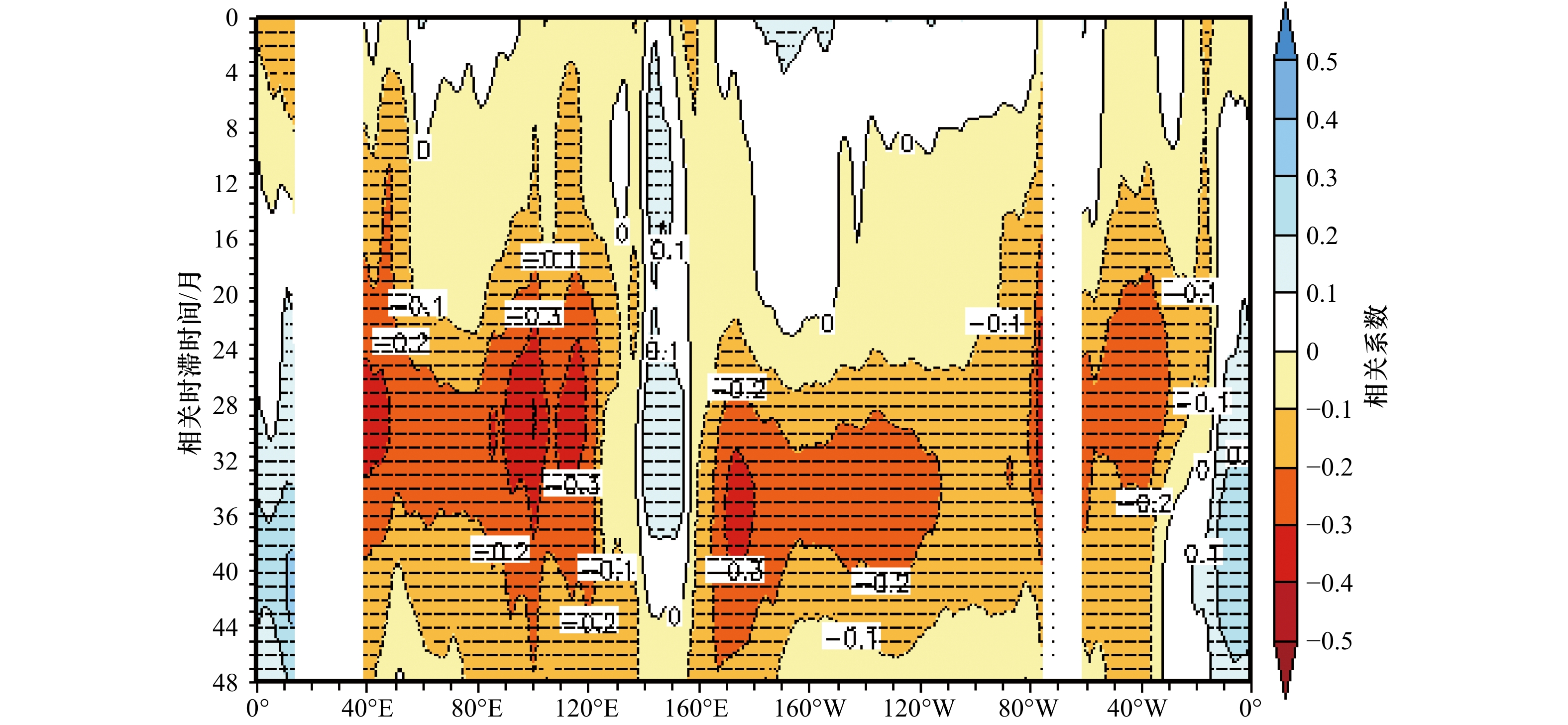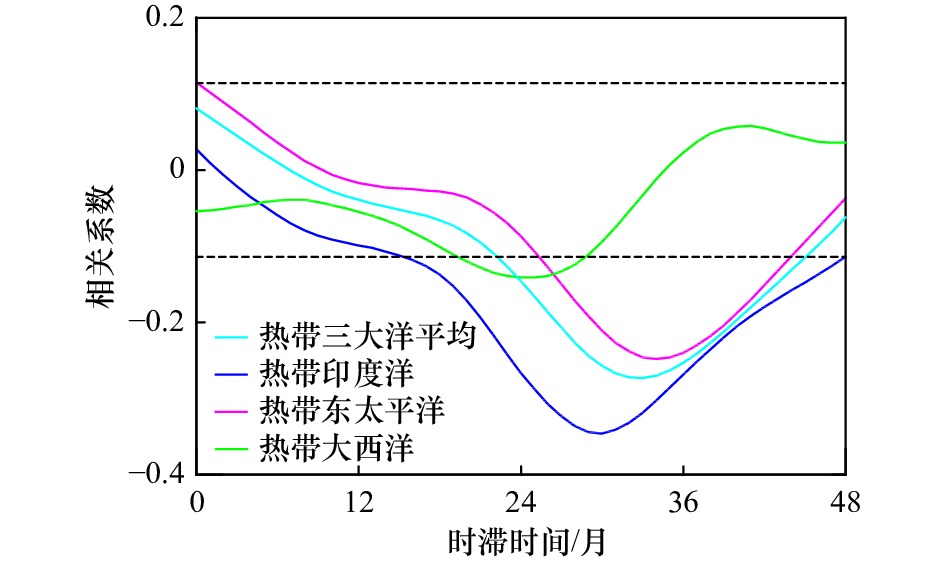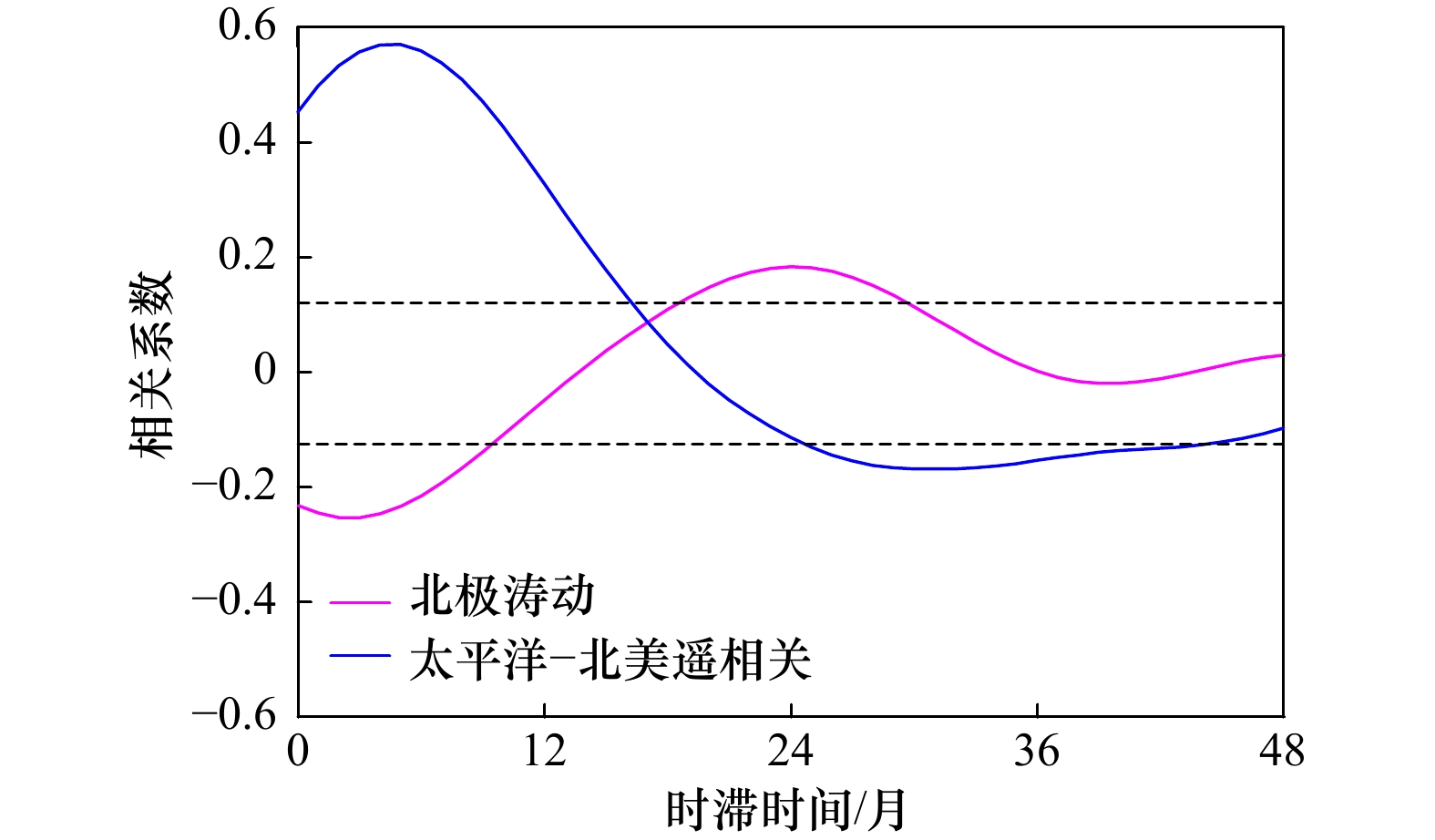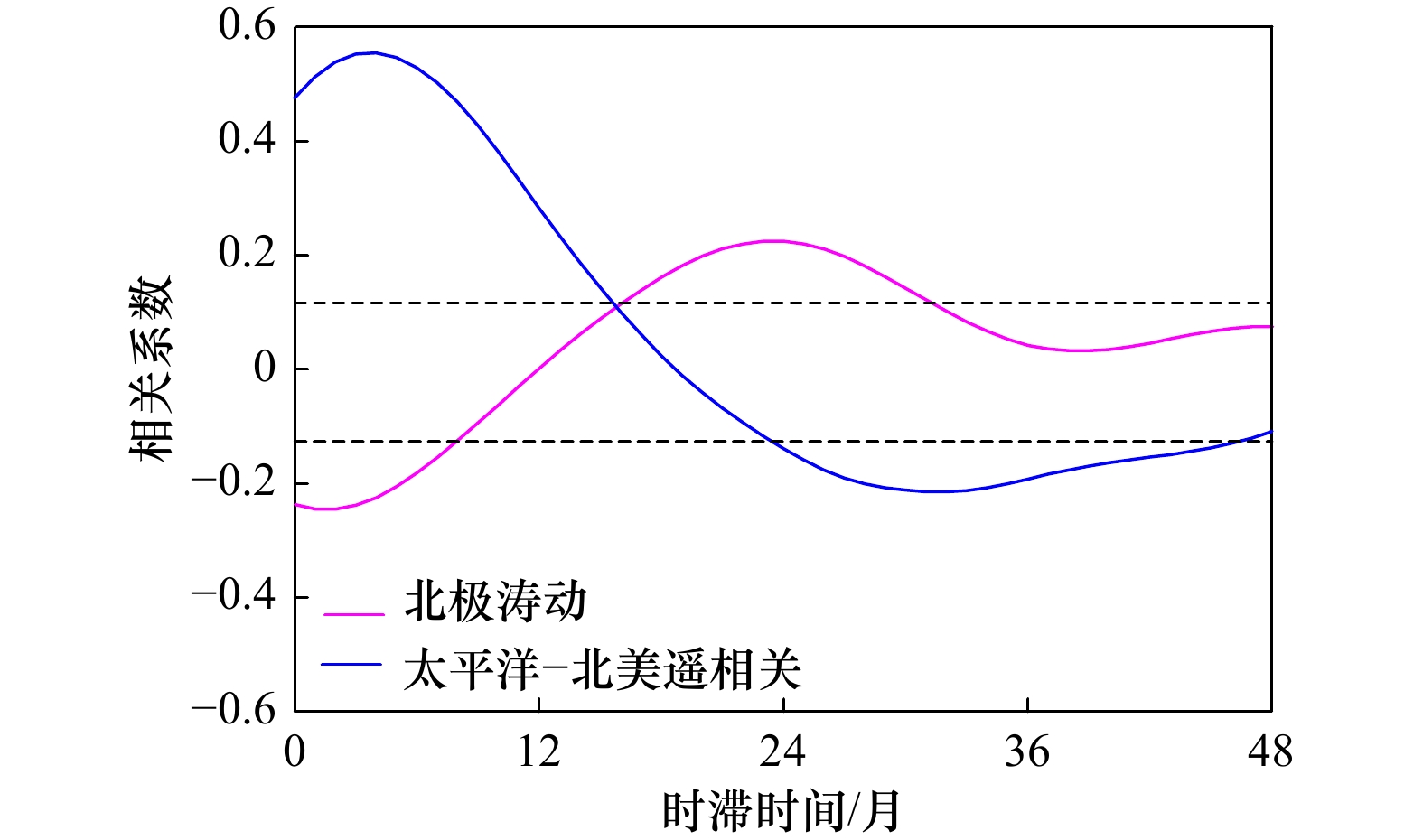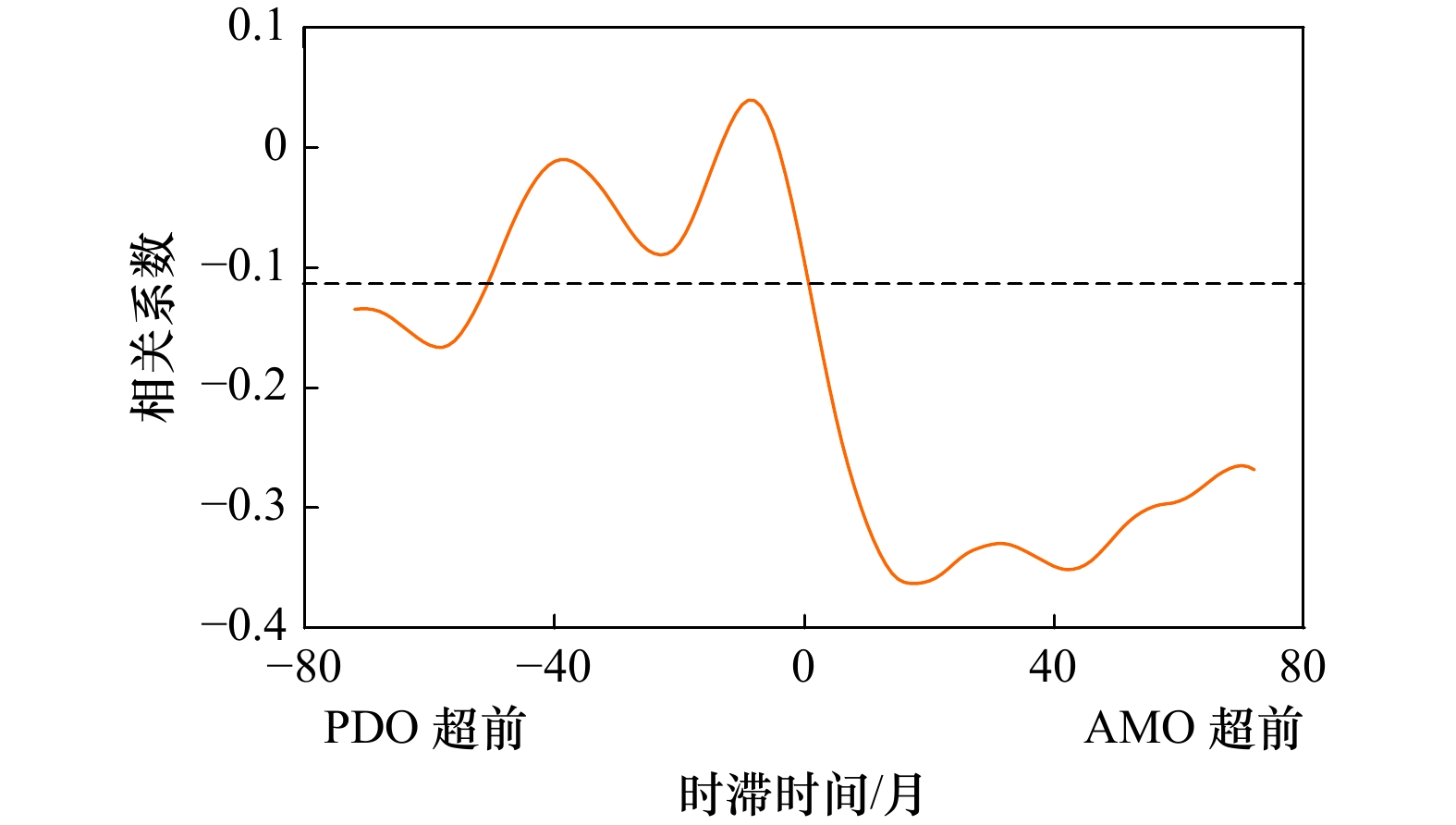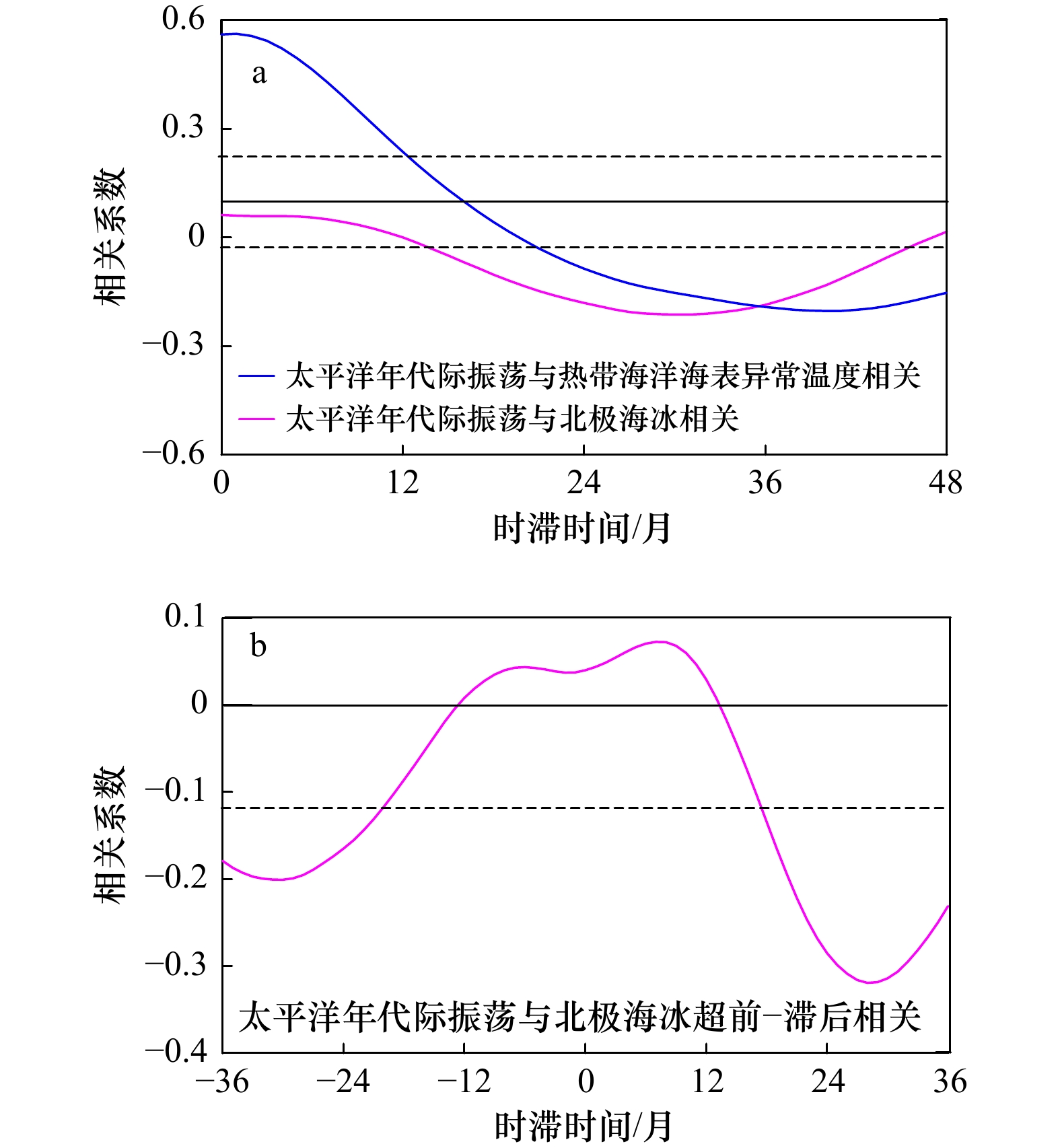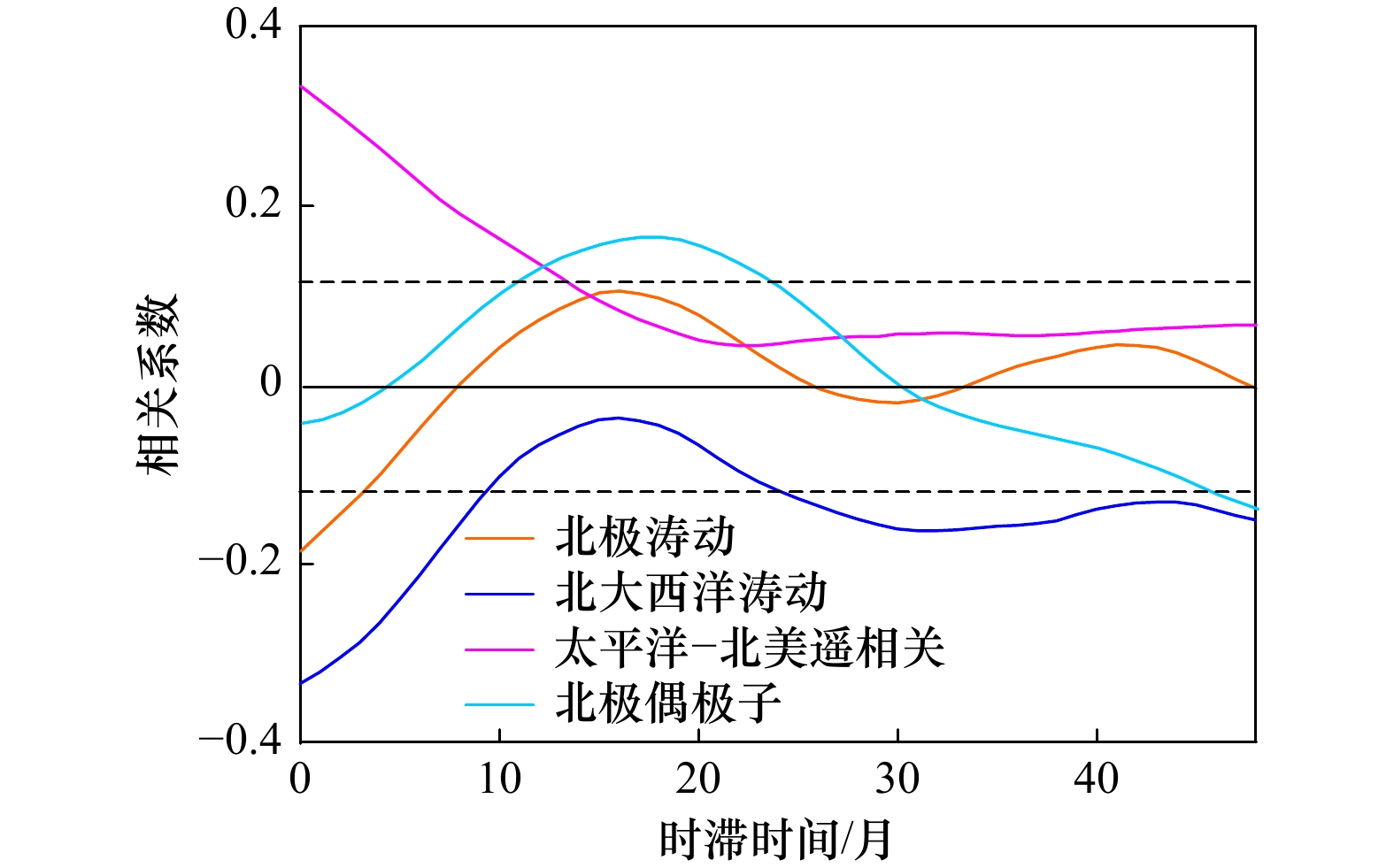Impact of global tropical sea surface temperature anomalies on the Arctic sea ice variation
-
摘要: 本文利用1951−2021年哈德莱中心提供的海冰和海温最新资料以及美国国家海洋和大气管理局气候预报中心提供的NCEP/NCAR再分析资料,分析探讨了北极海冰70余年的长期变化特征,进而研究了其快速减少与热带海温场异常变化之间的联系,揭示了在全球热带海洋海温场变化与北极海冰之间存在密切联系的事实。结果表明,北极海冰异常变化最显著区域出现在格陵兰海、卡拉海和巴伦支海。热带不同海区对北极海冰的影响存在明显时滞时间和强度差异,热带大西洋的影响相比偏早,印度洋次之,太平洋偏晚。热带大西洋、印度洋和中东太平洋海温异常影响北极海冰的最佳时间分别是后者滞后26个月、30个月和34个月,全球热带海洋影响北极海冰的时滞时间为33个月。印度洋SST对北极海冰的影响程度最强,其次是太平洋,最弱是大西洋。全球热带海洋对北极海冰的影响过程中,热带东太平洋和印度洋起主导作用。当全球热带海洋SST出现正(负)距平时,北极海冰会出现偏少(多)的趋势,而AO、PNA、NAO对北极海冰变化起重要作用,是热带海洋与北极海冰相系数的重要“纽带”。而AO、PNA和NAO不仅受热带海洋SST的影响,同时也受太平洋年代际振荡PDO和大西洋多年代际AMO的影响,这一研究为未来北极海冰快速减少和全球气候变暖机理的深入研究提供理论支撑。Abstract: This paper analyzes and discusses the long-term variation characteristics of Arctic sea ice using the latest sea ice and sea surface temperature (SST) data from 1951 to 2021 provided by Hadley Center and NCEP/NCAR reanalysis data from the Climate Prediction Center of National Oceanic and Atmospheric Administration (NOAA). The relationship between the rapid decrease of Arctic sea ice and surface sea temperature anomaly (SSTA) in tropical oceans is also investigated, revealing that there is a close relationship between the changes in tropical sea surface temperature field and the Arctic sea ice variation. The results show that the most significant sea ice changes occur in the Greenland Sea, the Kara Sea and the Barents Sea. Notably, the influence of the different tropical ocean areas on the Arctic sea ice shows noticeable temporal and spatial differences. The tropical Atlantic has the earliest impact on Arctic sea ice cover, followed by the Indian and Pacific oceans. Meanwhile, we found that 26-month, 30-month and 34-month lag is the optimal time-lagged correlation time period between Arctic sea ice and SSTA in the tropical Atlantic, the tropical Indian Ocean and Middle-Eastern Pacific, respectively and the mean value among them is a 33-month lag. The most substantial impact of SST on arctic sea ice occurs in the Indian Ocean, followed by the Pacific Ocean and the weakest in the Atlantic Ocean. When the tropical oceans appear positive (negative) SSTA, the arctic sea ice tends to be less (more). Moreover, Arctic Oscillation (AO), the Pacific-North American teleconnection (PNA), North Atlantic Oscillation (NAO) contribute significantly to the Arctic sea ice change, which are the key processes leading to the abnormal Arctic sea ice change. The AO, PNA and NAO are not only influenced by the SST of the tropical ocean, but also by the Pacific Ocean Decadal Oscillation (PDO) of the Atlantic Multi-decadal Oscillation (AMO). Our study aims to provide theoretical support for future research on the mechanism of the rapid decline of Arctic sea ice and global warming.
-
图 5 热带海洋10°S~10°N平均海表面温度与北极海冰变化的纬向−时滞相关图(1951−2021年)
图中点状分布表示相关区域达到99.9%信度检验水平,Y轴表示北极海冰密集度(ASIC)滞后异常海表面温度(SSTA)的时间
Fig. 5 Lag correlation between sea surface temperature along tropical ocean (10°S−10°N) and Arctic sea ice change (1951−2021)
The areas marked by dots indicates correlation exceeding 99.9% confidence level. Y axis indicate that month of the Arctic sea ice concentration (ASIC) lag behind sea surface temperature anomaly (SSTA)
图 6 北极海冰变化与热带海洋(印度洋、东太平洋、大西洋以及三大洋平均)海表面温度时滞相关曲线(1951–2021年)
热带三大洋平均SST(10°S~10°N,0°~180°~0°);热带印度洋SST(10°S~10°N,50°~110°E);热带大西洋SST (10°S~10°N,0°~50°W);热带东太平洋SST (10°S~10°N,180°~80°W);点线是相关达到 99.9%信度检验水平
Fig. 6 Time lag correlation curves (1951–2021) between Arctic sea ice change and sea surface temperature in tropical oceans (Indian Ocean, East Pacific Ocean, Atlantic Ocean, and the average of the three oceans)
Tropical oceans mean SST (10°S–10°N, 0°–180°–0°); Tropical Indian Ocean SST (10°S–10°N, 50°–110°E); Tropical Atlantic SST (10°S–10°N, 0°–50°W); Tropical East Pacific SST (10°S–10°N, 180°–80°W). Dotted lines are correlated exceed 99.9% confidence test level
图 8 热带中东太平洋海表面温度(SST)与北极涛动(AO)(红线)和太平洋–北美遥相关(PNA)(蓝线)时滞相关图
虚线表示相关性超过99.9%显著性水平
Fig. 8 Lag correlation curve of the sea surface temperature (SST) with Arctic Oscillation (AO) (red) and Pacific-North American telecorrelation (PNA) (blue) in the eastern tropical Pacific
Dashed is that correlation exceed 99.9% significance level
图 12 热带海洋表面温度与北半球位势高度时滞相关剖面图
a. 经向–时滞相关剖面(纬度平均);b. 纬向–时滞相关剖面(35°~50°N 平均)。样本 N=852;相关系数r=0.092 达到 95%信度检验水平
Fig. 12 Time lag correlation profiles of tropical ocean surface temperature and Northern Hemisphere geopotential height
a. Longitudinal-time-lag correlation profiles (latitudinal average); b. latitudinal-time-lag correlation profiles (35°−50°N average). Sample N=852; correlation coefficient r=0.092 reaches 95% confidence level
图 13 热带海洋异常海温偏低(a)和偏高(b)滞后 2 年北半球 500 hPa位势高度场合成图,以及后期对应的北极海冰偏多(c)和偏少(d)合成图
图中点状区域表示相关达到 99.9%信度检验水平
Fig. 13 Composite plot of the anomalous low (a) high (b) tropical ocean sea surface temperature lagged by 2 years in the Northern Hemisphere 500 hPa potential height field, and the corresponding composite plot of high (c) and low (d) Arctic sea ice
The dotted area in the figure indicates that the correlation reaches the 99.9% confidence test level
图 16 太平洋年代际振荡(PDO)和热带海洋海表异常温度(SSTA)与北极海冰时滞相关变化(a),以及太平洋年代际振荡(PDO)与北极海冰密集度(ASIC)超前−滞后相关(b)
Fig. 16 Time lag correlation changes of the Pacific Ocean Decadal Oscillation (PDO) with tropical ocean sea surface temperature anomaly (SSTA) and Arctic sea ice (a), and the time lag correlation between Pacific Ocean Decadal Oscillation (PDO) (b)
图 18 大西洋多年代际振荡(AMO)与北极涛动(AO)、北大西洋涛动(NAO)和太平洋−北美遥相关(PNA)以及北极偶极子(Arctic Dipole)的时滞相关曲线
Fig. 18 Time lag correlation curves of the Atlantic Multidecadal Oscillation (AMO) with the Arctic Oscillation (AO), North Atlantic Oscillation (NAO) and Pacific-North American telecorrelation (PNA), and the Arctic Dipole
-
[1] Serreze M C, Barrett A P, Stroeve J C, et al. The emergence of surface-based Arctic amplification[J]. The Cryosphere, 2009, 3(1): 11−19. doi: 10.5194/tc-3-11-2009 [2] Screen J A, Simmonds I. The central role of diminishing sea ice in recent Arctic temperature amplification[J]. Nature, 2010, 464(7293): 1334−1337. doi: 10.1038/nature09051 [3] Screen J A, Simmonds I. Increasing fall-winter energy loss from the Arctic Ocean and its role in Arctic temperature amplification[J]. Geophysical Research Letters, 2010, 37(16): L16707. [4] Kurtz N T, Markus T, Farrell S L, et al. Observations of recent Arctic sea ice volume loss and its impact on ocean-atmosphere energy exchange and ice production[J]. Journal of Geophysical Research: Oceans, 2011, 116(C4): C04015. [5] Petoukhov V, Semenov V A. A link between reduced Barents-Kara sea ice and cold winter extremes over northern continents[J]. Journal of Geophysical Research: Atmospheres, 2010, 115(D21): D21111. doi: 10.1029/2009JD013568 [6] Liu Jiping, Curry J A, Wang Huijun, et al. Impact of declining Arctic sea ice on winter snowfall[J]. Proceedings of the National Academy of Sciences of the United States of America, 2012, 109(11): 4074−4079. doi: 10.1073/pnas.1114910109 [7] Deser C, Tomas R, Alexander M, et al. The seasonal atmospheric response to projected Arctic sea ice loss in the late twenty-first century[J]. Journal of Climate, 2010, 23(2): 333−351. doi: 10.1175/2009JCLI3053.1 [8] Francis J A, Chan Weihan, Leathers D J, et al. Winter Northern Hemisphere weather patterns remember summer Arctic sea-ice extent[J]. Geophysical Research Letters, 2009, 36(7): L07503. [9] Hopsch S, Cohen J, Dethloff K. Analysis of a link between fall Arctic sea ice concentration and atmospheric patterns in the following winter[J]. Tellus A: Dynamic Meteorology and Oceanography, 2012, 64(1): 18624. doi: 10.3402/tellusa.v64i0.18624 [10] Jaiser R, Dethloff K, Handorf D, et al. Impact of sea ice cover changes on the Northern Hemisphere atmospheric winter circulation[J]. Tellus A: Dynamic Meteorology and Oceanography, 2012, 64(1): 11595. doi: 10.3402/tellusa.v64i0.11595 [11] Orsolini Y J, Senan R, Benestad R E, et al. Autumn atmospheric response to the 2007 low Arctic sea ice extent in coupled ocean-atmosphere hindcasts[J]. Climate Dynamics, 2012, 38(11/12): 2437−2448. [12] Porter D F, Cassano J J, Serreze M C. Local and large-scale atmospheric responses to reduced Arctic sea ice and ocean warming in the WRF model[J]. Journal of Geophysical Research: Atmospheres, 2012, 117(D11): D11115. [13] Strey S T, Chapman W L, Walsh J E. The 2007 sea ice minimum: impacts on the Northern Hemisphere atmosphere in late autumn and early winter[J]. Journal of Geophysical Research: Atmospheres, 2010, 115(D23): D23103. doi: 10.1029/2009JD013294 [14] IPCC. Climate Change 2013: The Physical Science Basis[M]. Cambridge: Cambridge University Press, 2013. [15] 沈永平, 王国亚. IPCC第一工作组第五次评估报告对全球气候变化认知的最新科学要点[J]. 冰川冻土, 2013, 35(5): 1068−1076.Shen Yongping, Wang Guoya. Key findings and assessment results of IPCC WGI fifth assessment report[J]. Journal of Glaciology and Geocryology, 2013, 35(5): 1068−1076. [16] Stroeve J, Holland M M, Meier W, et al. Arctic sea ice decline: faster than forecast[J]. Geophysical Research Letters, 2007, 34(9): L09501. [17] Wang Muyin, Overland J E. A sea ice free summer Arctic within 30 years: an update from CMIP5 models[J]. Geophysical Research Letters, 2012, 39(18): L18501. doi: 10.1029/2012GL052868 [18] Bader J, Mesquita M D S, Hodges K I, et al. A review on Northern Hemisphere sea-ice, storminess and the North Atlantic Oscillation: observations and projected changes[J]. Atmospheric Research, 2011, 101(4): 809−834. doi: 10.1016/j.atmosres.2011.04.007 [19] Outten S D, Esau I. A link between Arctic sea ice and recent cooling trends over Eurasia[J]. Climatic Change, 2012, 110(3/4): 1069−1075. [20] Francis J A, Vavrus S J. Evidence linking Arctic amplification to extreme weather in mid-latitudes[J]. Geophysical Research Letters, 2012, 39(6): L06801. doi: 10.1029/2012GL051000 [21] Wu Bingyi, Su Jingzhi, Zhang Renhe. Effects of autumn-winter Arctic sea ice on winter Siberian High[J]. Chinese Science Bulletin, 2011, 56(30): 3220−3228. doi: 10.1007/s11434-011-4696-4 [22] Wu Bingyi, Handorf D, Dethloff K, et al. Winter weather patterns over Northern Eurasia and Arctic sea ice loss[J]. Monthly Weather Review, 2013, 141(11): 3786−3800. doi: 10.1175/MWR-D-13-00046.1 [23] Honda M, Inoue J, Yamane S. Influence of low Arctic sea-ice minima on anomalously cold Eurasian winters[J]. Geophysical Research Letters, 2009, 36(8): L08707. doi: 10.1029/2008GL037079 [24] Mori M, Watanabe M, Shiogama H, et al. Robust Arctic sea-ice influence on the frequent Eurasian cold winters in past decades[J]. Nature Geoscience, 2014, 7(12): 869−873. doi: 10.1038/ngeo2277 [25] Liu Na, Liu Jiping, Zhang Zhanhai, et al. Is extreme Arctic sea ice anomaly in 2007 a key contributor to severe January 2008 snowstorm in China?[J]. International Journal of Climatology, 2012, 32(13): 2081−2087. doi: 10.1002/joc.2400 [26] Tang Q, Zhang X, Yang X, et al. Cold winter extremes in northern continents linked to Arctic sea ice loss[J]. Environmental Research Letters, 2013, 8(1): 14−36. [27] Serreze M C, Barry R G. Processes and impacts of Arctic amplification: A research synthesis[J]. Global and Planetary Change, 2011, 77(1−2): 85−96. doi: 10.1016/j.gloplacha.2011.03.004 [28] 左涛, 陈锦年, 王凡. 中部型El Niño与北极海冰变化的联系[J]. 海洋湖沼通报, 2015, 37(3): 1−13.Zuo Tao, Chen Jinnian, Wang Fan. The contribution of central Pacific El Niño (La Niña) to the Arctic sea ice variation[J]. Transactions of Oceanology and Limnology, 2015, 37(3): 1−13. [29] 陈迪, 高山红, 陈锦年. 印太暖池区域海温异常与北极海冰变化的联系[J]. 极地研究, 2016, 28(1): 49−57.Chen Di, Gao Shanhong, Chen Jinnian. Impact of the indo-pacific warm pool SST anomaly on arctic sea ice variation[J]. Chinese Journal of Polar Research, 2016, 28(1): 49−57. [30] Rayner N A, Parker D E, Horton E B, et al. Global analyses of sea surface temperature, sea ice, and night marine air temperature since the late nineteenth century[J]. Journal of Geophysical Research: Atmospheres, 2003, 108(D14): 4407. doi: 10.1029/2002JD002670 [31] Kalnay E, Kanamitsu M, Kistler R, et al. The NCEP/NCAR 40-year reanalysis project[J]. Bulletin of the American Meteorological Society, 1996, 77(3): 437−472. doi: 10.1175/1520-0477(1996)077<0437:TNYRP>2.0.CO;2 [32] Fetterer F, Knowles K, Meier W, et al. Sea ice index, Version 3[R]. Boulder, Colorado USA: National Snow and Ice Data Center, 2017. [33] Liang X S. Unraveling the cause-effect relation between time series[J]. Physical Review E, 2014, 90(5): 052150. doi: 10.1103/PhysRevE.90.052150 [34] Dickson B. All change in the Arctic[J]. Nature, 1999, 397(6718): 389−391. doi: 10.1038/17018 [35] Fetterer F, Knowles K. Sea ice index monitors polar ice extent[J]. Eos, Transactions American Geophysical Union, 2004, 85(16): 163. doi: 10.1029/2004EO160007 [36] Nakamura T, Yamazaki K, Iwamoto K, et al. A negative phase shift of the winter AO/NAO due to the recent Arctic sea-ice reduction in late autumn[J]. Journal of Geophysical Research: Atmospheres, 2015, 120(8): 3209−3227. doi: 10.1002/2014JD022848 [37] Zhang Shuyu, Gan T Y, Bush A B G. Variability of Arctic sea ice based on quantile regression and the teleconnection with large-scale climate patterns[J]. Journal of Climate, 2020, 33(10): 4009−4025. doi: 10.1175/JCLI-D-19-0375.1 -





 下载:
下载:
